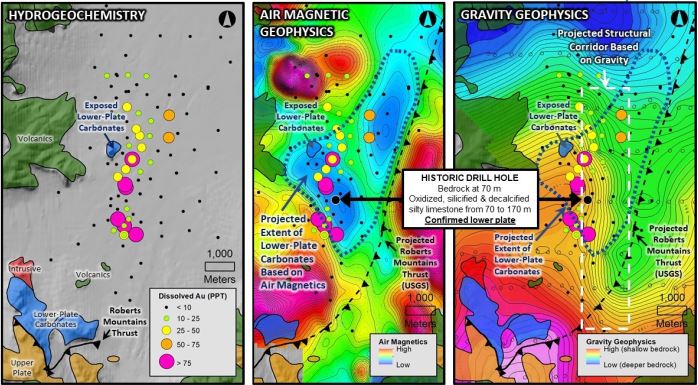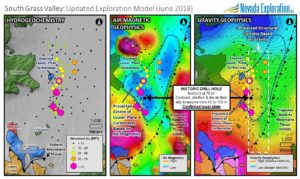Historical drilling provides evidence of shallow, hydrothermally-altered lower-plate bedrock and Nevada Exploration acquires additional 1,900 ha at South Grass Valley – Cortez Trend, Nevada


Nevada Exploration Inc. (“NGE” or the “Company”) (TSX-V: NGE; OTCQB: NVDEF) is pleased to report that a review of historic drilling at its South Grass Valley Project has provided further evidence for the presence of shallow hydrothermally-altered lower-plate bedrock at the company’s South Grass Valley Project (the “Project”). The Company is also pleased to report that it has significantly increased its land holdings at the Project by staking 227 new claims covering 1,900 ha, bringing the Company’s total holdings at this district-scale project to 4,100 ha.
Based on a review of historic activity in and around the Project, NGE has learned that during the late 1990s eight shallow reverse-circulation (RC) drill holes were drilled in the Project area. The summary drill logs show that one of the drill holes located in the area where NGE has projected shallow, lower-plate bedrock (based on the recently announced results of its airborne magnetic survey – see news release dated April 12, 2018) encountered oxidized, silicified, and decalcified limestone, siltstone, and sandstone, beginning at a depth of only 70 metres and continuing to the bottom of the hole at 170 metres.
Discussing the importance of the results, NGE’s CEO, Wade Hodges: “This information is incredibly important for the Project because it confirms what we had before only been able to project. We now know with much more certainty that the thick sequence of favourable lower-plate host rocks exposed in the adjacent outcrop 800 meters to the west, containing the same types of bedrock units associated with the mineralization at Cortez to the north, continue under cover beneath our focused exploration target. We now have additional evidence for favourable Carlin-type alteration, as well as oxidation, which likely provided the mechanism to release the gold and related suite of Carlin-type pathfinder elements we see in the groundwater at the Project. Also of importance, we now know that the depth to bedrock across the Project is much shallower than we had estimated earlier, which we expect to translate into lower exploration costs. This information checks many of the boxes we were hoping to see in our own drilling and allows us to better target our planned deeper drilling program, which together we believe have further de-risked the project.”
About the South Grass Valley Project
NGE’s 100% owned 41 km2 South Grass Valley Project is located at the southern end of Grass Valley, the covered valley immediately south of Barrick’s Cortez complex (Pipeline, Cortez Hills, and Goldrush), one of the world’s largest and lowest cost gold mines with annual production of approximately one million ounces.
Two bedrock outcrops spaced 5 km apart at the Project exhibit Carlin-type gold deposit-style alteration and geochemistry within a 700-metre-thick sequence of lower-plate carbonate host rocks immediately below the Roberts Mountains Thrust. Based on the historic drilling, the 2018 air magnetic geophysics, and the gravity geophysics, there is strong evidence that these favourable host rocks are present under relatively shallow cover across a large portion of the Project. This large area of favourable geology is intersected by a high-angle fault corridor that projects under the cover from the exposed range front (based on mapping and gravity geophysics), providing a potential major conduit to expose the favourable host rocks to mineralized hydrothermal fluids.
From November 2017 to January 2018, NGE completed 69 infill groundwater sampling boreholes at South Grass Valley to follow up on a gold-in-groundwater anomaly identified during a regional-scale, generative exploration program. The objectives of NGE’s infill program were to establish the extent, size, and magnitude of the gold-in-groundwater footprint at South Grass Valley, its relationship to the larger prospective geologic setting, and to constrain the target for a deeper drilling program. In total, NGE has now completed 135 boreholes across the Project area, collecting samples from most boreholes at multiple depths, for a total of 234 groundwater samples.
The results of NGE’s infill borehole program have defined a 1,000 x 4,000 metre N-S oriented zone of enriched gold, arsenic, antimony, barium, thallium, tungsten, and sulfate in groundwater, representing a hydrogeochemistry footprint consistent in size and magnitude (including gold up to 800 times background) with those seen around Lone Tree and Twin Creeks, large known gold deposits on the Cortez Trend, as well as at NGE’s Kelly Creek Project. Importantly, this zone of enrichment is coincident with the projected intersection of the major N-S high-angle fault corridor and the favourable lower-plate carbonate host rocks.
Based on the size of the zone of enriched gold in groundwater footprint and the size of the area of projected lower-plate host rocks intersected by the high-angle fault corridor, NGE believes that the target is large enough to support a district-scale mineral system, and is now suitably constrained for a focused deeper drilling program to evaluate the potential for economic mineralization.
For more information about the Company’s South Grass Valley Project, including our most recent technical presentation, readers are encouraged to visit: http://nevadaexploration.com/projects/south_grass/
About Nevada Exploration Inc.
NGE is an exploration company advancing a portfolio of new district-scale gold exploration projects along Nevada’s Cortez Trend. NGE is led by an experienced management team that has been involved in several significant discoveries in Nevada, including the discovery of Lone Tree and Rabbit Creek (part of the Twin Creeks Mine). NGE’s team has spent the last decade integrating the use of hydrogeochemistry with conventional exploration tools to develop a Nevada-specific regional-scale geochemistry exploration program. With innovative technology, NGE has completed the world’s largest groundwater sampling program for gold exploration, collecting approximately 6,000 samples to evaluate Nevada’s covered basins for new gold exploration targets. To advance follow-up targets, NGE has overcome the high drilling costs that have previously prohibited the wide-spread use of drilling as a prospecting tool by developing its Scorpion drill rig, a small-footprint, truck-mounted, small-diameter RC drill rig specifically tailored to the drilling conditions in Nevada’s basins (analogous to RAB drilling in other parts of the world). By integrating hydrogeochemistry and early-stage low-cost drilling with conventional exploration methods, NGE is overcoming the challenges and radically reducing the costs of exploring in Nevada’s covered basins, and taking significant steps to open this important new search space up for district-scale exploration.
For further information, please contact:
Investor Relations
Nevada Exploration Inc.
Email: info@nevadaexploration.com
Tel: +1 (604) 601 2006
Website: www.nevadaexploration.com
